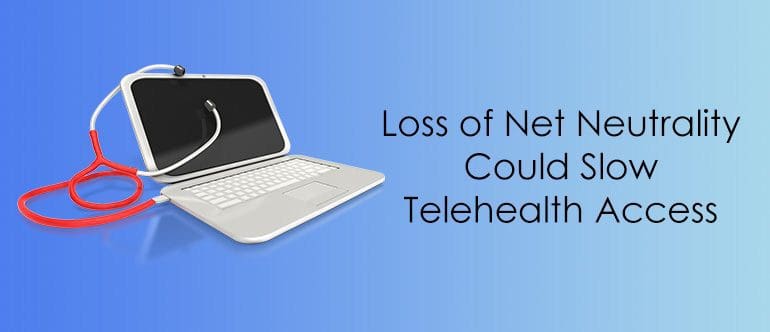Call us toll-free: 800-878-7828 — Monday - Friday — 8AM - 5PM EST

By Meg Bryant for Healthcare Dive
December is a time to reflect on the coming new year and make resolutions for the coming year to enact change. For the federal government, the repeal of net neutrality rules by the Federal Communications Commission was one decision that will continue to create aftershocks in 2018.
Net neutrality barred broadband providers from slowing information slow or exacting higher payments for speedy delivery. The move could have serious ramifications for telehealth and other digital health services, particularly in rural and under-served communities. And with CMS’ penalty structure for readmissions in place and the move to consumerism, providers need to figure out their digital strategy and what the FCC’s decision means for them.
Why net neutrality matters to healthcare
Under net neutrality, no carrier could randomly charge more than another for access to broadband. With its removal, broadband servers can now block content, offer “fast lanes” for preferred customers and slow data for those who can’t afford to pay for faster transmission. Subscriber-based video streaming services like Netflix and AT&T’s DirectTV Now could be prioritized over a rural public hospital facility seeking to transmit images or conduct a telehealth consult.
“The ability for hospitals to access internet service providers and bandwidth is a ‘has to’ in healthcare,” says Robert Annas, chief operating officer of Eagle Telemedicine and senior managing director at SOLIC Capital, adding a tier-based ability to pay by nature will have a negative impact on providers.
In rural markets, small physician practices branching out into telehealth won’t be able to absorb those costs and will pass them along to the patient, putting such outpatient services out of reach for some. Given the growing physician shortage, the result will be weakened ability to provide good quality care, Annas says.
On the inpatient side, larger health systems will have the ability to pay for bandwidth access, but smaller systems will suffer. The pressure to provide speedy service could accelerate the trend of consolidation and hospital closures.
Internet as a social determinant of health
The loss of net neutrality will force healthcare organizations to rely more on electronic health record (EHR) vendors like Cerner and Epic to provide them with the technological support they need to be able to move health records electronically, and consumers will pay for that cost, says Beatriz Mallory, SVP and managing director at Sensis Health.
It will also exacerbate the rate at which internet access is a social determinant of health, because there will now be entire communities with less access to preventive care, prenatal care and chronic disease management, she tells Healthcare Dive. “What you’ll see is more reliance on episodic care” and use of emergency rooms, she says.
FCC Chairman Ajit Pai defended the commission’s 3-2 vote along party lines to end net neutrality by citing a 5.6% decline in internet investment during the two years the policy was in effect. “This is especially hard on rural and low-income urban communities, parts of the country that already find themselves on the wrong side of the digital divide,” he said in a video explaining the commission’s adoption of his Restore Internet Freedom proposal.
Could healthcare be an exception?
“What’s fascinating to me is that the government has mandated electronic health records and has provided incentives for years to do that and those systems require bandwidth,” Annas tells Healthcare Dive. He and others believe healthcare should have a separate lane with different rules.
It stands to reason the government would isolate certain sectors like healthcare and telemedicine from a net neutrality-type package because it reduces access to healthcare, rather than increases it, he explains. Not doing so goes against the grain of logical thinking.
Ron Exler, principal analyst at ISG Research, sees such a carve-out as a possibility. “Potentially, healthcare applications could be given the very priority many worry creates inequities,” he told Healthcare Dive via email. He notes there are other significant obstacles to connected healthcare such as reimbursement, privacy protection and interoperability that also need to move forward. Moreover, many connected applications, such as asset management, rely on RF technology rather than broadband.
Practical steps
But for telehealth and many other day-to-day healthcare activities, access to speedy bandwidth is essential.
To that end, providers should continue to make their voices heard on the need for priority bandwidth access in healthcare, experts say. Health systems should also be actively negotiating with their internet providers to get the best deal possible for now. In a non-neutral environment, it will boil down to how well one negotiates and what kind of dollar volume they bring to bear.
A Senate bill to reverse FCC’s net neutrality decision will see its day on the Senate floor. Sen. Claire McCaskill (D-Mo.) announced on Monday support for the bill, totaling the measure’s support to 30 senators, ensuring a Senate floor vote.
While the outcomes of that vote is unclear, the FCC’s decision still stands for now. As such, providers need to think outside the box.
Smaller hospitals and physician practices should consider banding together with hospitals of similar size to expand their purchasing power. Rural hospital associations can create bandwidth consortiums that buy bandwidth in bulk, increasing access to all members.
A substantial incremental investment is needed in telemedicine and more uptake by providers who have lingered on the sidelines, says Mallory, adding that whatever happens to the Affordable Care Act, CMS’ penalty structure for readmissions is not going away.
“Eliminating the net neutrality rules goes against the thought of reducing healthcare costs, because reducing healthcare costs is done when you are in front of disease — not behind it,” says Annas.
